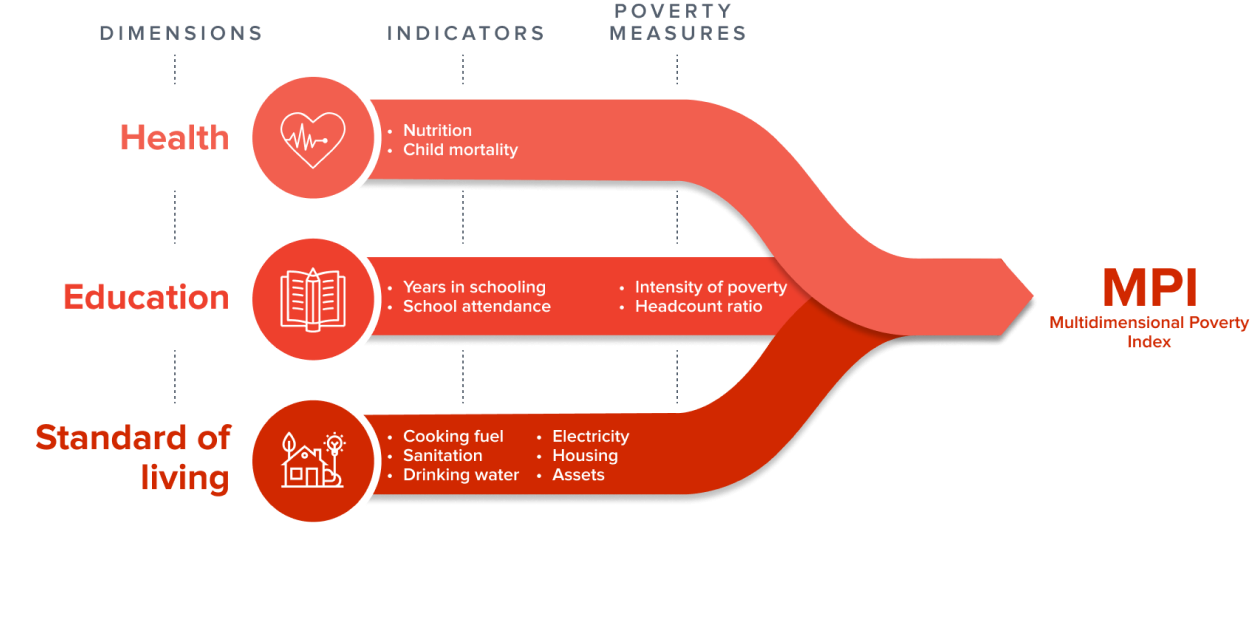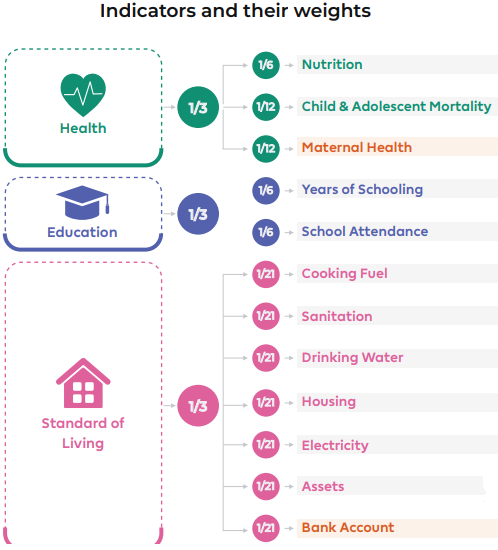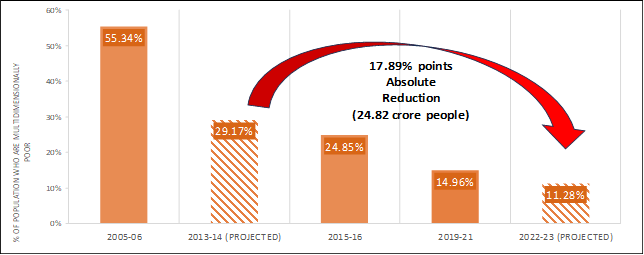Social Justice
Multidimensional Poverty Index: NITI Ayog
- 16 Jan 2024
- 7 min read
For Prelims: NITI Aayog, Multidimensional Poverty, National Family Health Surveys (NFHS), Sustainable Development Goals, Poshan Abhiyan, Anemia Mukt Bharat.
For Mains: Multidimensional Poverty Index: NITI Ayog, Importance of Eradicating Multidimensional Poverty in Achieving Sustainable Development Goals.
Why in News?
Recently, the NITI Aayog has released a Discussion Paper titled-‘Multidimensional Poverty in India since 2005-06’, stating that 24.82 crore people escaped Multidimensional Poverty in the last nine years.
- The discussion paper utilizes data from National Family Health Surveys (NFHS) conducted in 2005-06, 2015-16, and 2019-21 to understand long-term poverty trends.
What is the National Multidimensional Poverty Index?
- The National Multidimensional Poverty measures simultaneous deprivations across three equally weighted dimensions of Health, Education, and Standard of Living that are represented by 12 Sustainable Development Goals-aligned indicators.
- These include Nutrition, Child and Adolescent mortality, Maternal Health, Years of schooling, School Attendance, Cooking fuel, Sanitation, Drinking water, Electricity, Housing, Assets, and Bank Accounts.
- MPI’s global methodology is based on the robust Alkire and Foster (AF) method that identifies people as poor based on universally acknowledged metrics designed to assess acute poverty, providing a complementary perspective to conventional monetary poverty measures.
- However, the National MPI covers 12 indicators while global MPI covers 10 indicators.
| Global MPI Indicators | National MPI Indicators |
 |
 |
What are the Key Highlights of the Multidimensional Poverty Index in India Since 2005-2006?
- Overall Decline in Multidimensional Poverty:
- India has experienced a significant reduction in multidimensional poverty from 29.17% in 2013-14 to 11.28% in 2022-23, marking a decrease of 17.89% points.
- Approximately 24.82 crore people have escaped multidimensional poverty in the last nine years (2013-14 to 2022-23). This positive change is attributed to various initiatives by the government.
- State-wise Decline:
- Uttar Pradesh, Bihar, Madhya Pradesh, and Rajasthan have recorded the sharpest decline in the number of people classified as poor based on the MPI.
- Uttar Pradesh saw the largest decline with 5.94 crore people escaping multidimensional poverty, followed by Bihar at 3.77 crore, Madhya Pradesh and Rajasthan.
- Uttar Pradesh, Bihar, Madhya Pradesh, and Rajasthan have recorded the sharpest decline in the number of people classified as poor based on the MPI.
- Improvement in All Indicators:
- All 12 indicators of the MPI have shown significant improvement, reflecting progress in Health, Education, and Standard of Living dimensions.
- Severity of Deprivation:
- The Severity of Deprivation (SoD) declined at a slightly lower rate between 2015-16 and 2019-21 compared to 2005-06 and 2013-14.
- SoD measures deprivations the average multidimensionally poor person suffers from.
- At the same time, reduction of deprivation was faster after 2015-16 in terms of reduction in share of MPI poor out of total population compared to the decade before, owing to a lesser number of years.
- In 2005-06, the share of MPI poor in India’s total population was 55.34%.
- The Severity of Deprivation (SoD) declined at a slightly lower rate between 2015-16 and 2019-21 compared to 2005-06 and 2013-14.
- SDG Target Achievement:
- India is likely to achieve Sustainable Development Goals (SDG) Target 1.2, which aims to reduce "at least by half the proportion of men, women, and children of all ages living in poverty in all its dimensions according to national definitions" well before 2030.
- Indicators related to the standard of living dimension showed significant improvements, such as reduced deprivation in cooking fuel, sanitation facilities, and access to bank accounts.
- Drivers Helped in Declining MPI:
- Initiatives like Poshan Abhiyan and Anemia Mukt Bharat have significantly enhanced access to healthcare facilities, leading to a substantial decrease in deprivation.
- Operating one of the world's largest Food Security programs, the Targeted Public Distribution System under the National Food Security Act covers 81.35 crore beneficiaries, providing food grains to rural and urban populations.
- Recent decisions, such as extending free food grain distribution under Pradhan Mantri Garib Kalyan Anna Yojana for another five years, exemplify Government's commitment.
- Various programs addressing maternal health, clean cooking fuel distribution through Ujjwala Yojana, improved electricity coverage via Saubhagya, and transformative campaigns like Swachh Bharat Mission and Jal Jeevan Mission have collectively elevated living conditions and overall well-being of people.
- Additionally, flagship programs like Pradhan Mantri Jan Dhan Yojana and PM Awas Yojana have played pivotal roles in financial inclusion and providing safe housing for the underprivileged.
What is NITI Aayog?
- About:
- The Planning Commission was replaced by a new institution – NITI Aayog on 1st January, 2015 with emphasis on ‘Bottom –Up’ approach to envisage the vision of Maximum Governance, Minimum Government, echoing the spirit of ‘Cooperative Federalism’.
- It has two Hubs,
- Team India Hub acts as an interface between States and Centre.
- Knowledge and Innovation Hub builds the think-tank acumen of NITI Aayog.
- Initiatives:
- SDG India Index
- Composite Water Management Index
- Atal Innovation Mission
- SATH Project.
- Aspirational District Programme
- School Education Quality Index
- District Hospital Index
- Health Index
- Agriculture Marketing And Farmer Friendly reform Index
- India Innovation Index
- Women Transforming India Awards
- Good Governance Index
UPSC Civil Services Examination, Previous Year Questions (PYQs)
Prelims
Q. Atal Innovation Mission is set up under the (2019)
(a) Department of Science and Technology
(b) Ministry of Labour and Employment
(c) NITI Aayog
(d) Ministry of Skill Development and Entrepreneurship
Ans: (c)
Q. The Government of India has established NITI Aayog to replace the (2015)
(a) Human Rights Commission
(b) Finance Commission
(c) Law Commission
(d) Planning Commission
Ans: (d)
Mains
Q. How are the principles followed by the NITI Aayog different from those followed by erstwhile Planning Commission in India? (2018)








